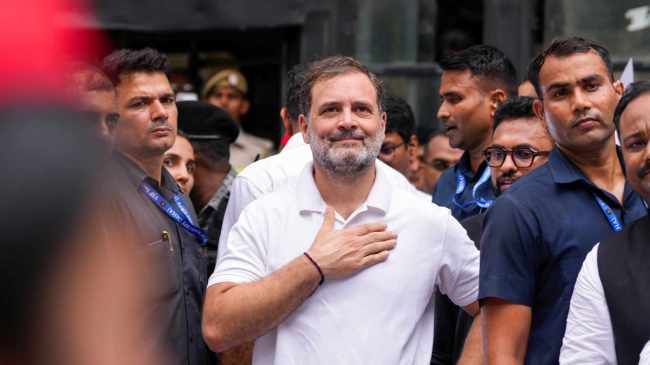Vote Chori vs Voter Rights: Rahul Gandhi’s Bihar Yatra Turns into Big Opposition Battle Ahead of Elections

Image via The indian Express
Patna, August 17, 2025 – Rahul Gandhi has begun his 16-day Voter Adhikar Yatra from Sasaram, Bihar. This march is not just another political rally. It is being projected as a battle to “save democracy” and stop what the opposition calls “vote chori”—the alleged large-scale deletion of voters’ names through the Special Intensive Revision (SIR) of electoral rolls. The Yatra will cover 1,300 km, passing through 23 districts, 50 Assembly seats, and 29 Lok Sabha constituencies, before ending with a massive rally at Patna’s Gandhi Maidan on September 1.
What is “Vote Chori” and Why It Matters
The word “vote chori” means vote theft. Opposition leaders allege that the Election Commission’s SIR process unfairly removes names from voter lists. They argue that poor, migrant, and marginalized groups suffer the most because they may not have the full set of required documents.
The opposition believes this is not just an error but a deliberate attempt to reduce their support base before elections. They point to areas where minorities and backward classes form a strong vote bank, saying many of their names have disappeared.
On August 14, 2025, the Supreme Court intervened. It ordered the Election Commission to publish lists of deleted voters online and accept Aadhaar or Voter ID as valid documents for objections. The court’s move was celebrated by the opposition as a victory for democracy. Yet, the Election Commission strongly denied the “vote chori” charge, saying the SIR is transparent and legal.
Route and Scale of the Yatra
Rahul Gandhi’s Yatra is massive in scale.
- Length and reach: Over 1,300 km in 16 days.
- Districts covered: 23, including politically sensitive areas like Bhagalpur, Katihar, and Gaya.
- Assembly seats: 50, many of them swing seats that can decide the final outcome.
- Lok Sabha constituencies: 29, with a mix of caste and community dominance.
These regions are crucial. In the 2020 Assembly elections, the opposition alliance had won 21 of these 50 seats. The RJD secured 12, Congress bagged 7, and Left parties won 2. The Yatra now aims to expand that performance and gain momentum for 2025.
Opposition Unity on Display
Rahul Gandhi is not walking alone. He will be joined by several leaders from the INDIA bloc:
- Tejashwi Yadav (RJD), seen as the young face of Bihar’s opposition.
- Dipankar Bhattacharya (CPI-ML), who has a strong rural and working-class base.
- Leaders from CPI and CPI(M), further strengthening the message of unity.
This unity is important because Bihar politics is deeply divided along caste lines. The combined presence of these leaders sends a message that the opposition is serious about challenging the ruling party on the ground.
The Message: One Man, One Vote
Rahul Gandhi has framed this Yatra as a fight for the Constitution and democracy. He repeatedly says it is about protecting the principle of “one man, one vote”.
He has invited farmers, youth, laborers, and women to walk with him. His speeches emphasize that no one should be denied their basic right to vote just because of missing documents or biased rules.
To make the campaign more relatable, Rahul released a viral video inspired by the film Laapataa Ladies. Using the line “Chori chori, chupke chupke… the public has woken up”, he accused the Election Commission of trying to quietly steal votes. The video quickly spread online, giving the campaign a cultural push.
Political Stakes in Swing Seats
The Yatra passes through swing constituencies where elections are usually close. These include Bhagalpur, Kadwa, and Kaimur. Winning even a small percentage more votes in these areas can shift the overall result.
Analysts say the march is carefully designed. It mixes districts with high Dalit, OBC, and minority populations with seats where Congress and RJD are relatively weak. This way, Rahul hopes not only to protect existing seats but also to expand the INDIA bloc’s reach.
Supreme Court Order Adds Drama
The Supreme Court’s August 14 order has become a turning point. The Court gave the Election Commission a deadline of August 19, 5 pm to publish details of deleted names. It also directed the EC to accept Aadhaar and voter ID as proof for objections.
The opposition calls it a “slap on the face of vote thieves.” They say it proves that their protest is justified.
The Election Commission, however, maintains its stand. It even issued a clarification after a Congress video went viral, accusing the party of misleading voters.
This clash has turned the issue of vote chori into a national debate.
Why Bihar?
Bihar has always been politically sensitive. It has 40 Lok Sabha seats and a history of shaping national politics. Many of its constituencies are considered “swing regions” that can decide the final tally in both Assembly and General Elections.
By launching his march here, Rahul Gandhi is directly targeting regions where the opposition still has strong chances. The Yatra is not only about Bihar—it is a signal to the whole country that the Congress and INDIA bloc are ready to fight for voter rights.